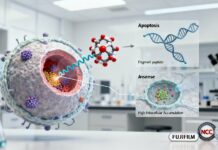Proteins comprise many smaller parts called amino acids strung together in a certain order. There are 20 different amino acids; they combine in various sequences to form thousands of proteins. Each Protein, therefore, has its specific structure and function determined by these sequences. Proteins are very important in the body; they build and repair tissues, act as enzymes speeding up chemical reactions, and form antibodies in order to support the immune system. In addition, they are involved in hormone regulation and the transport of molecules across the cell membrane. Our bodies couldn’t function without proteins.
Protein Structure and Function
Protein function is directly related to the shape. For instance, some enzymes have particular shapes to attach to their substrates and activate reactions. When the shape of a protein changes, for example, because of temperature or pH, the Protein becomes denatured and no longer has the function. That is why proper bodily condition needs to be maintained. Proteins that allow them to fold improperly can cause diseases, which makes it all the more important that proteins fold correctly.
Common Proteins in the Human Body
Proteins are important in our health; many are seen as keys. Red blood cells are full of hemoglobin that carries oxygen to all other parts of the body from the lungs. Skin, bones, and connective tissues get structure and strength from collagen. Insulin is a hormone made in the pancreas by giving the blood sugar level a way to enter the cells. They are the antibodies the immune system creates to protect you from infections by recognizing and destroying invaders (bacteria, viruses, etc.) that are not part of your body. But these are also just some proteins that keep us alive, showing the range of proteins that do the job.
Methods of Studying Proteins
Finding out about proteins makes it easier for scientists to understand how they work and how they make you healthy or sick. Coomassie blue is one of the more important tools in protein research, an aid in laboratory experiments that detect and measure the proteins being studied.
Techniques for Isolating Proteins
Researchers use several methods to isolate proteins from cells and tissues:
- Centrifugation: A method of separating components based on density by spinning samples at high speeds.
- Chromatography: Separating proteins based on size, charge, or binding properties.
- Electrophoresis: Separating different-sized proteins through a gel by moving them using an electric field.
These techniques help scientists obtain pure proteins for detailed study.
Ways to Measure Protein Amounts
Protein levels need to be measured to understand biological processes and diagnose disease. Spectrophotometry measures the absorbance of light by a solution containing a protein. ELISAs rely on a protein binding to an antibody to indicate its presence. In mass spectrometry, the mass and charge of proteins are identified and quantified. These methods are accurate means for determining the concentration of proteins in samples.
New Methods in Protein Visualization
These developments in technology have evolved how we see proteins. But for many proteins, which are incredibly small and difficult to crystallize, scientists can use techniques such as X-ray crystallography to see how X-rays diffract through a crystallized protein, thereby determining the Protein’s three-dimensional structure. Proteins are cooled and imaged at very low temperatures with cryo-electron microscopy so they remain in their natural structure. Researchers use nuclear magnetic resonance (NMR) spectroscopy to investigate proteins in solution, revealing their structure and dynamics. Finding new biological and medical discoveries with these methods helps us understand proteins at the molecular level.
Proteins and Diseases
For the Protein to work correctly, it must fold itself into a specific shape. Sometimes, the proteins fold themselves the wrong way and become misfolded. Misfolded proteins can form clumps, which are bad for the cells. For instance, in Alzheimer’s, amyloid beta–misfolded proteins accumulate in the brain and disrupt nerve cell function. In Parkinson’s disease, the alpha-synuclein proteins become misfolded and form toxic aggregates. The poor protein folding conditions presented here are examples of how wrong protein folding can cause neurodegenerative diseases affecting millions of people worldwide.
Proteins in the Immune System
The immune system depends on proteins. White blood cells make proteins called antibodies that recognize and destroy pathogens such as bacteria and viruses. If the body detects an invader, it produces antibodies targeted solely at that invader. Proteins called cytokines also help control the immune response by communicating between cells. But if the proteins go awry, it can cause immune disorders. For example, autoimmune diseases happen when the immune system assaults the body’s proteins and mistakes them for foreign proteins. Understanding these protein functions is key to managing and treating immune-related conditions.
Using Proteins as Medicines
Proteins are not only the cause of disease but also have a therapeutic role. Protein-based medicines have many modern medicines and targeted therapies. Some examples include:
- Insulin: Use to control blood sugar levels in diabetes.
- Monoclonal Antibodies, designed to target specific cells or proteins, are used to treat cancers and autoimmune diseases.
- Vaccines: Storing protein parts of pathogens that can provoke an immune system without causing illness.
Protein-based medicines have rewritten history in healthcare by offering great treatments for complicated conditions.
Protein Supplements: Pros and Cons
Various sources create several types of protein supplements. Soy protein contains all essential amino acids and is plant-based, meaning it’s suitable for both vegetarians and vegans. Because yellow split peas are hypoallergenic and easy to digest, they make a great pea protein source for those with dairy or soy sensitivities.
Benefits and Risks of Taking Supplements
Benefits:
- Convenient Nutrition: Supplements are one of the easiest ways to boost protein intake, particularly useful for those who require more Protein or live busy lives.
- Muscle Growth: They resemble organs and support muscle repair and growth, particularly with resistance training. They can be combined with resistance training.
- Weight Management: Following high-protein diets can increase one’s feeling of fullness, which might help one lose weight!
Risks:
- Digestive Issues: Bloated, crampy, or diarrheal in some people.
- Added Ingredients: Some products contain added sugars, artificial flavors, or fillers, which may not be desired.
- Allergic Reactions: Allergy dairy, soy, or anything else sufferers should be careful.
- Kidney Strain: Taking in too much Protein can cause undue stress on the kidneys, particularly if you already have some kidney injury.
If you weigh the pros and cons, you will want to determine whether protein supplements are appropriate.
Safe Supplement Use Tips
Suppose you have a health condition or are worried about using protein supplements safely. In that case, seeking a healthcare professional’s advice before adding such supplements to your diet is a good idea. Remember about products: Choose from reputable brands that have been third-party tested for whatever they make their products with. By reading labels and being on the lookout for unwanted additives and for products that meet your nutritional needs, you avoid having to read them. Keep to recommended serving sizes and stay aware that supplements complement a balanced diet, not replace whole-food Protein sources. Safe and effective use can be monitored and intake adjusted, providing your body’s response.
The Future of Protein Research
Personalized medicine entails determining by what genetic factors healthcare needs to be tailored. Doctors analyze proteins produced in a person’s body to identify specific biomarkers linked to diseases. This allows for:
- Targeted Therapies: The ability to develop treatments that react specifically to proteins integral to a disease.
- Predictive Medicine: Knowing that given certain medications in advance, a patient might have a particular reaction to certain medications based on their protein expression.
- Customized Drug Dosages: Optimizing medication level (ies) to achieve maximum efficacy and minimize side effects.
The approach is to reduce patients’ variability to improve treatment outcomes, taking into account the individual’s protein makeup.
New Developments in Protein Science
In recent years, our understanding of proteins has been greatly expanded by recent innovations. Such techniques as proteomics, the study of proteins on a large scale, reveal where proteins within cells come together and what they do. With the development of gene editing tools like CRISPR-Cas9, genes can now be precisely edited to genes that code for proteins to correct genetic disorders. In addition, artificial proteins with new functions can change the face of medicine and industry. The potential certainly exists in these developments to solve complex health challenges and further scientific knowledge.
Considering the Ethics in Protein Studies
Ethical considerations are becoming increasingly important as protein research progresses. However, if personal protein data were collected and analyzed, issues like genetic privacy would need to be guarded with a strong hand. There’s also the question of ensuring that new treatments are open to all equally because advancements should not favor the more privileged. Here, the use of animals in research is ethically problematic regarding welfare and the necessity of such studies. Maintaining public trust and inclusive benefits from research requires balancing scientific progress with ethical responsibility.
Why Studying Proteins Matters
Proteins are crucial to just about every aspect of life, from how our bodies function to how we fight disease to how we age. So, by understanding how proteins function or work, we improve medical treatments, diagnostics, and preventive strategies, thereby better understanding biological processes. Proteins are at the heart of innovation, from creating targeted cancer therapies to sustainable food sources. Modern biologists are sometimes depicted as living in an alternate universe where we don’t know the laws. Still, by deepening our knowledge of proteins, we not only unlock the mysteries of life but also pave the way for healthier futures for us all.


















